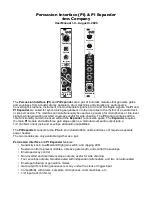
Velocity Sensing
The envelope outputs of the
PI
can respond to the velocity of the input signal. Velocity is a term usually
used for percussive sounds when referencing how hard an instrument is hit (harder means more
velocity, and softer means less). When using non-percussive audio sources such as vocals, keyboards,
etc, you can think of velocity as a combination of the loudness of the notes (or perhaps the “attack” of
the notes). When using sound sources that don’t produce distinct notes, you can think of velocity as a
measurement of how loud the signal gets whenever there’s a transition from quiet to loud.
When sensing velocity, the
PI
must be in
Follow
mode. The
Env. Out
and
Inv. Out
jacks will produce
envelopes with an amplitude that depends on the velocity of the input signal. Harder hits will produce
envelopes with higher peak voltages, and softer hits will produce lower voltages.
The following discussion provides an example of one way to setup a
PI
for velocity sensing, using an
acoustic drum and a microphone as the input source. These concepts can be applied to most other
audio sources.
Setting the Velocity Response
While velocity-sensitive envelopes are generated whenever the
PI
is in
Follow
mode, setting
Sensitivity
properly is important so that the entire range of velocity (very soft to very hard) produces a
wide range of envelopes. If
Sensitivity
is set too high, then medium and hard hits will not be
distinguished. On the other hand, if the knob is set too low, very soft hits will barely be detected.
A good rule-of-thumb is that if the gate output is firing only at your hardest hits (and not at medium or
soft hits), then the
Env. Out
jacks will be outputting velocity-sensitivity envelopes with plenty of
headroom and enough gain to respond to the dynamic range of a normal playing style.
A basic procedure for finding a good velocity-sensitivity range is as follows:
1. Flip the switch to
Follow.
2. Turn
Sensitivity
all the way up.
3. While hitting the drum with maximum velocity, turn
Sensitivity
down until the gate no longer triggers.
4. Nudge
Sensitivity
up until the
PI
gate begins to
fire again.
At this setting, the
Env. Out
and
Inv. Out
jacks will
dynamically respond to the velocity of the input signal: soft
hits will produce low-voltage envelopes, and hard hits will
produce higher voltage envelopes. This outcome is shown
in
Figure 7.
The red signal is the input, the blue line is the
Env. Out
signal, and the orange pulse is the
Gate
output.
If you find that the envelope output level is too high, use
the
Level
knobs and attenuated envelope output jacks on
the
PI Expander
. While the
Sensitivity
knob can also be used to attenuate the output
level, adjusting it changes the velocity sensitivity range as well as the threshold at which the
Gate
output fires. The
Level
knobs, on the other hand, only controls the output level on the
PI Expander
and
should be the preferred method for attenuating envelopes.
Troubleshooting and Suggested Applications
If the
Sensitivity
knob (or
L|M|H
gain range switch) is set
too high, the input signal will clip internally, indicated by
the input light flashing pink or red. This causes the
PI
to
output an envelope around the maximum voltage
regardless of the input velocity, illustrated in
Figure 8
.
Though this may be desired in some applications, it
restricts the dynamic range of the envelope output.
Turning down the
Sensitivity
or flipping the
L|M|H
switch
to a lower gain setting will solve this issue.
Another issue to consider is the
Decay
setting. If the
Decay
knob is set too high, the envelope will fall so slowly
that it’ll never reach a low value before it’s triggered again. See
Figure 9
for an example.
Page of
10
16
Figure 7
Figure 8
















